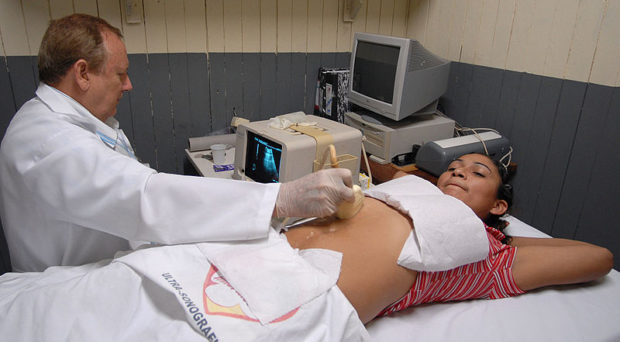High-Tech Impacts of Ultrasound in Health Care
Ultrasound technology is a vital part of health care. It is utilized for a variety of diagnostic purposes, but until recently, all an ultrasound could be used for was viewing the inside of the human body. New advances in this technologyhave shown great promise in internal medicine applications. Where can ultrasound be applied in internal medicine, and what implications does it have for the future of ultrasound technology?

Current Ultrasound Applications
Ultrasounds are traditionally used for imaging, usually in internal medicine and prenatal applications. Common newer applications for ultrasound technology include:
- Shock Wave Lithotripsy — This process utilizes targeted ultrasound waves to break up kidney stones and other calcium-based growths in the body. It’s most commonly used to break up stones that are too large to pass, or ones that will not pass naturally. It is an alternative to surgery.
- Dental Descaling — Ultrasounds have been used for periodontal therapy in the form of ultrasound debridement. When used correctly, ultrasound debridement is more efficient and effective than manual debridement.
There are other less common uses for ultrasound technology, but they are not as widely applied or studied.
- Ultrasound for Liver Tumors
Traditional treatment for liver cancer and tumors is to surgically remove the malignant tissue, then treat any remaining cells with a combination of radiation and chemotherapy. By utilizing targeted ultrasound waves, liver tumors can be destroyed without the need for surgical intervention. The waves, emitted by more than 1,000 micro-emitters, cauterize the tissue inside the body.
It is not an easy procedure — the liver moves with the patient’s breath, so treatment requires the patient to either hold their breath or be sedated. The liver also lies behind the rib cage, so the emitters need to be calibrated to avoid doing damage to the ribs. By pairing real-time MRI imagery with these micro-emitters, surgery can be avoided by destroying the malignant cells without the need for invasive surgery.
Additionally, the use of ultrasound technology to cauterize tumors internally would prevent the creation of surgical smoke, which can cause a dangerous decrease in surgeon visibility. Surgical smoke is a hazard for any procedure that utilizes electro-cauterization techniques.
- Immunotherapy-Based Cancer Treatment
Immunotherapy treatment for cancer has become a companion for traditional treatments, utilizing medication to stimulate the patient’s own immune system to fight cancer cells. Many of these new treatments have been approved by the FDA, but they are just starting to become commonplace.
A new treatment technique, currently in preclinical trials, pairs these immunotherapy treatments with ultrasound technology. Early findings suggest ultrasound treatment helps improve a patient’s immune response, helping their body’s immune system fight cancer more effectively. The treatment is noninvasive and unlike radiation therapy, it doesn’t have any negative side effects. It also doesn’t negatively affect the immune system.
- Bone Healing and Joint Therapy
Broken bones, traditionally, take anywhere from 3 to 10 weeks to heal, depending on the age and health of the patient and the severity of the break.
By utilizing low-intensity pulsed ultrasound (LIPUS), studies have shown increased healing rates of anywhere from 24 percent to 42 percent when applied to fresh fractures. While healing rates do drop for older fractures, overall success rates are high. Some success rates are upwards of 80 percent.
The exact reason ultrasounds help bones knit is unknown, but it has seen a unique application in the form of a 3-D printed cast that aids healing with the use of ultrasound waves. While it’s only a prototype, it could easily become the next advancement in bone repair.
Ultrasound technology could potentially change the way noninvasive surgery and treatments are done. These advances can save lives, decrease healing time and do a whole lot more than just look inside the body.
